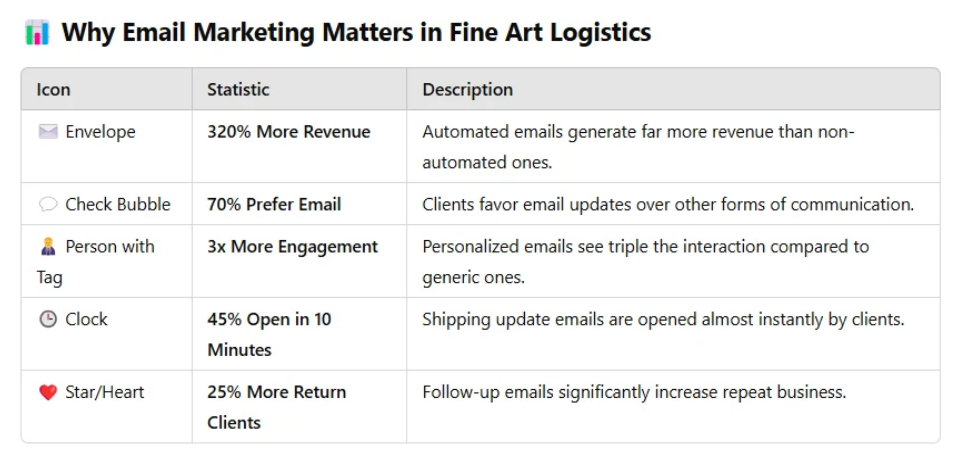Clear communication is crucial in the world of fine art shipping. Clients entrust valuable, often irreplaceable pieces to logistics companies and expect precision, professionalism, and transparency. Leveraging email marketing to enhance client communication in fine art shipping is no longer a bonus—it’s essential. This tool has evolved far beyond newsletters and promotions. With the right strategy, email marketing becomes a steady bridge between shippers and collectors, keeping everyone informed, engaged, and confident throughout the transport process.
Real-Time Shipping Updates: Building Trust from the Start
Every fine art shipment comes with high stakes. A collector or gallery expects timely updates, especially during transit. Automated email workflows can deliver real-time notifications—pick-up confirmations, customs clearances, and delivery schedules.
By integrating shipping management systems with email tools, companies ensure each message is relevant and timely. Whether it's a piece moving across states or across borders, consistent updates reduce client anxiety and limit the need for back-and-forth calls.
According to recent data, automated emails generate 320% more revenue than non-automated emails. While revenue may not be the central focus for every shipment, this stat reveals how automation leads to stronger, more reliable engagement—something art shipping clients deeply value.
 Personalized Communication Without the Guesswork
Personalized Communication Without the Guesswork
Clients appreciate feeling seen, especially in luxury or high-value sectors. Segmenting email lists based on client types—such as private collectors, galleries, and auction houses—makes communication relevant without overwhelming the inbox.
For instance, a gallery owner might need status updates for multiple works in transit. A single collector may want additional assurance regarding climate-controlled storage. Using dynamic email content ensures each recipient receives the right message without manual effort.
Automation doesn’t mean robotic messages. Instead, it enables thoughtful, responsive interactions at scale, keeping client confidence high and opening the door for future repeat business.
Sharing Value-Added Content: More Than Just Logistics
Email is not just for logistics—it’s also a chance to educate and inform. Fine art shipping companies can use emails to share helpful resources: how to prepare art for pick-up, tips for insuring valuable pieces, or insights into handling delicate items.
Beyond packing advice, clients may enjoy periodic updates on art market trends, global art fair schedules, or insights into customs clearance for certain regions. This kind of content positions the company not just as a service provider but as a valuable resource in the fine art world.
Content can be scheduled monthly or quarterly, ensuring regular emails without being intrusive. The key is relevance—giving recipients something they can use or learn from without ever feeling like they’re being sold to.
Professional Promotional Campaigns and Service Announcements
Sometimes, clients need a gentle nudge to book their next shipment or explore a new service offering. Promotions or service updates—such as expanded coverage areas, upgraded insurance options, or climate-controlled storage availability—can be effectively announced through email with clarity and professionalism.
Rather than a sales-heavy tone, the messaging should remain informative and respectful. Fine art clients appreciate transparency and expect regular updates that reflect the premium nature of the service.
For seasonal campaigns, consider reminders ahead of major art events or auction deadlines. A simple message, such as “Now scheduling shipments for Art Basel week,” provides value while prompting timely bookings.
Follow-Up Emails: An Easy Way to Improve
After delivery, email continues to serve a purpose. Sending follow-up messages asking for feedback not only helps improve internal processes but also shows the client that their opinion matters.
Simple, well-designed feedback forms linked in post-delivery emails can gather insights about timing, service quality, and communication. It’s also a subtle way to keep the brand in mind for future needs.
If a shipment involves extra care or complex logistics, a brief note acknowledging that effort can go a long way. These small gestures—automated or manual—strengthen client relationships.
Automating Without Losing the Human Touch
There’s often concern that automation feels impersonal, especially in high-touch services. However, modern email tools enable automated sequences that still convey a human touch. Warm language, thoughtful content, and appropriate timing create the impression of direct, attentive service—even when systems are running the show behind the scenes.
This approach frees up operations teams while ensuring no client feels left out or forgotten. When done right, automation enhances—not replaces—the human relationships that define fine art shipping.
Why It Pays to Use Smart Email Strategy
Using email marketing in fine art shipping isn’t about volume—it’s about clarity, relevance, and trust. From real-time updates to expert resources, innovative email strategies can transform client experience from uncertain to confident. As the industry evolves, fine art logistics companies that embrace this communication tool are better equipped to meet modern expectations. For those unsure where to begin, partnering with email marketing experts can lead to measurable improvements in both satisfaction and retention.
